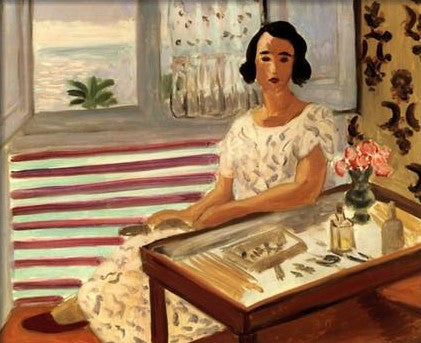Description
In the painting "Woman Seated at Her Dressing Table" from 1924, Henri Matisse invites us to contemplate a composition that is as intimate as it is enigmatic. The work, which measures 43x35 cm, captures a scene in which a woman is seated in front of her dressing table, a private moment transformed into an object of artistic admiration. This is another example of Matisse's mastery in turning the banal into something extraordinary, using his unique visual language.
The figure of the woman, at the heart of the composition, emanates an atmosphere of serenity and reflection. The relaxed posture of her body, with her hands resting gently on her lap, suggests a moment of introspection or perhaps simple daily routine. She wears a simple white dress that delicately contrasts with the bright colors of the background. The lack of specific facial details forces us to focus on the scene as a whole, giving a universal character to her presence.
The dressing table, the central object of the scene, is represented with a geometric simplification characteristic of Matisse's style. Its straight lines and defined shapes create a harmonious contrast with the soft, organic curves of the woman's body. The objects on the dressing table, although sketched schematically, suggest the presence of cosmetics and other typical elements of a grooming ritual, providing a sense of authenticity and everyday life.
The use of color in this painting is a feat of Matisse's talent. The vibrant tones are employed in such a way that they create a sense of depth and texture through seemingly simple forms. The background is composed of ornamental patterns in greens and pinks that fill the scene with life without overwhelming the viewer or detracting from the central figure. This almost decorative pattern reminds us of the oriental and textile influences that frequently inspired the artist.
Henri Matisse, an eminent figure of Fauvism, is known for his ability to use color in innovative and emotive ways. His focus on simplification and bold use of pure colors is evident in this work, where even the smallest details are important to the overall composition. The arrangement of colors, and how they juxtapose to create vivid contrasts, is a testament to his color theory and his deep understanding of how colors affect emotions and perception.
The work "Woman Seated at Her Dressing Table" also reflects Matisse's interest in capturing moments of daily life. This theme of the everyday, elevated through art, can be seen in many of his other works, where simple and domestic scenes become rich tapestries of color and form. In this painting, as in many others, the artist uses his surroundings and familiar objects to explore the expressive possibilities of color and line.
Matisse was at a point in his career where he had moved beyond the excessive use of Fauvist techniques and had reached a maturity in his art that combined simplicity with deep expressiveness. The economy of lines and the exuberance of color in "Woman Seated at Her Dressing Table" are reflections of this artistic evolution.
In summary, the apparent simplicity of "Woman Seated at Her Dressing Table" hides an emotional and technical complexity that highlights the genius of Henri Matisse. The painting is not only a representation of an intimate moment but also a masterpiece of composition and color that continues to resonate more than a century after its creation. It leaves us with a poetic vision of day-to-day life, transforming a daily ritual into an affirmation of life and art.

